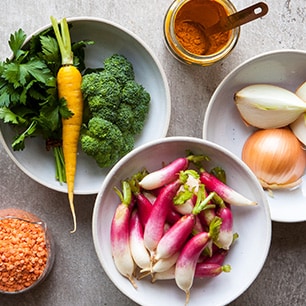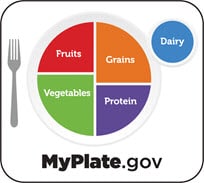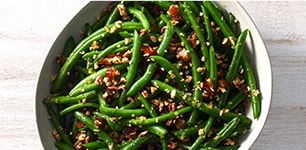Updated October 26, 2021
Explore new eating styles with added health benefits. Consuming more plant-based foods and reducing animal-derived foods may lower your risk of coronary heart disease.5 Think beyond vegetarian as you explore new tips and trends for plant-based eating styles.

Now trending: plant-based foods.
Maybe you’ve heard about a growing wellness trend called plant-based eating. It generally consists of whole, unprocessed foods—mainly vegetables, fruits, beans, whole grains, nuts, and seeds. Plant-based diets may have great benefits for heart health and can help you shift toward better eating patterns.
Though vegetarian and vegan styles of eating may be front of mind when you think about plant-based diets, there are options to suit almost any need and preference—even for those who want to continue enjoying meat, fish, or other animal-based foods.
Defining plant-based eating styles.1
Flexitarian: mostly vegetarian; some meat
Lacto-ovo vegetarian: dairy and egg products; no meat, fish, or fowl
Ovo vegetarian: egg products; no meat, fish, fowl, or dairy
Lacto vegetarian: dairy products; no meat, fish, fowl, or eggs
Pescatarian: fish; no steak, chicken, pork, or other meat
Vegan: no animal products (meat, fish, fowl, eggs, dairy, honey, etc.)
Perks of plants.
Heart benefits: Research shows plant-based diets are linked with lower cholesterol and lower risk of coronary heart disease.5 But you don’t have to give up all meat—just eat more plant-based than animal foods.
Environmental benefits: By eating less meat, you may even reduce your carbon footprint. According to a research study, vegetarian diets have the lowest carbon footprint compared with diets that include meat and animal products.2
Greater availability: More meat alternatives are now available to consumers than ever before.3 With growing trends in plant-based foods, you’ll find a variety of options at your neighborhood Publix.
Keep it interesting.
Go beyond the basics of whole grains, beans, fruits, and vegetables. Here are some ways to add variety to your plant-based menu:
- Enjoy unsweetened plant-based milks, such as soy, almond, oat, and cashew.
- Our Deli offers new hummus flavors that are savory, colorful, and spicy. Change it up with black bean or vegetable hummus.
- Choose drinks, protein powders, and nutrition bars that have pea and vegetable proteins. Replace whey with plant-based protein powders (located near our supplements) in your favorite smoothie.
- Discover expanding meat alternatives in the Produce department, including tofu, tempeh, and jackfruit.
- You’ll also find plenty of plant-based meals and veggie burgers in the frozen section.
Be sure to look for the green Better Choice shelf tags to select products with less saturated fat, added sodium, or added sugar.
Trendy veggies.
As plant-based foods shift toward the center of the plate, some vegetables are gaining star status.
- Riced cauliflower is growing in popularity and makes a great alternative to rice, potatoes, and pasta. It’s available in our Produce department and frozen section.
- Spiralized vegetables, including zucchini and butternut squash, work well in many recipes. Find them in our Produce department or frozen food section.
- Pulses and legumes are practically everywhere—even in dried snacks and pasta.
Steps to plant-based success.
If you’re looking for ways to get more vegetables and other plant-based foods into your diet, set some simple goals:
- Build breakfasts around oatmeal or whole grain cereal. Toast a slice of whole grain bread and top it with avocado or nut butter. Include fresh fruit.
- Prepare a vegetarian recipe one night a week. Lentil Bolognese over Zoodles is a hearty dish that’s sure to please.
- Fill at least half of your dinner plate with salad greens and cooked or raw vegetables.4
- Incorporate unsaturated fats, such as nuts, seeds, avocados, or olive oil.
- Go plant-based for breakfast by enjoying a Tofu Scramble.
- Serve a plant-based appetizer, such as Fall Root Vegetable Stacks.
- The Mediterranean diet is ideal for plant-based eating.

As you continue your wellness journey, explore new paths to plant-based eating with our recipes, products, and tips.
For the love of you.
Choosing how you eat is uniquely personal. It’s about your needs, your preferences, and your goals. As your wellness ally, Publix is in your corner with fresh ideas, recipes, and wellness icons that make it easier to shift toward wiser food choices. It’s all about you, at your very best.
Sources
1 What Are the Different Types of Vegetarians? The Vegetarian Resource Group. Accessed September 21, 2021.
2 Chapa, James, Brian Farkas, Regan L. Bailey, and Jen-Yi Huang. Evaluation of Environmental Performance of Dietary Patterns in the United States Considering Food Nutrition and Satiety. Science of the Total Environment 722 (June 2020).
3 Nielsen Consumer LLC. Examining Shopper Trends in Plant-Based Proteins: Accelerating Growth Across Mainstream Channels. NielsenIQ. September 9, 2021.
4 United States Department of Agriculture (USDA). MyPlate. MyPlate.gov. Accessed September 21, 2021.
5 Satija, Ambika, and Frank B. Hu. Plant-Based Diets and Cardiovascular Health. Trends in Cardiovascular Medicine 28, no. 7 (October 2018): 437–41.

 You are about to leave publix.com and enter the Instacart site that they operate and control. Publix’s delivery and curbside pickup item prices are higher than item prices in physical store locations. Prices are based on data collected in store and are subject to delays and errors. Fees, tips & taxes may apply. Subject to terms & availability. Publix Liquors orders cannot be combined with grocery delivery. Drink Responsibly. Be 21. For prescription delivery, log in to your pharmacy account by using the Publix Pharmacy app or visiting
You are about to leave publix.com and enter the Instacart site that they operate and control. Publix’s delivery and curbside pickup item prices are higher than item prices in physical store locations. Prices are based on data collected in store and are subject to delays and errors. Fees, tips & taxes may apply. Subject to terms & availability. Publix Liquors orders cannot be combined with grocery delivery. Drink Responsibly. Be 21. For prescription delivery, log in to your pharmacy account by using the Publix Pharmacy app or visiting 
